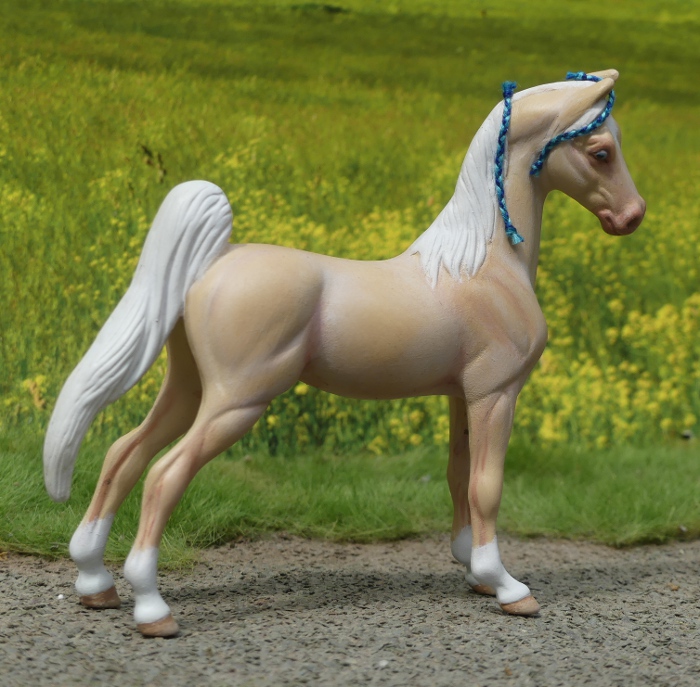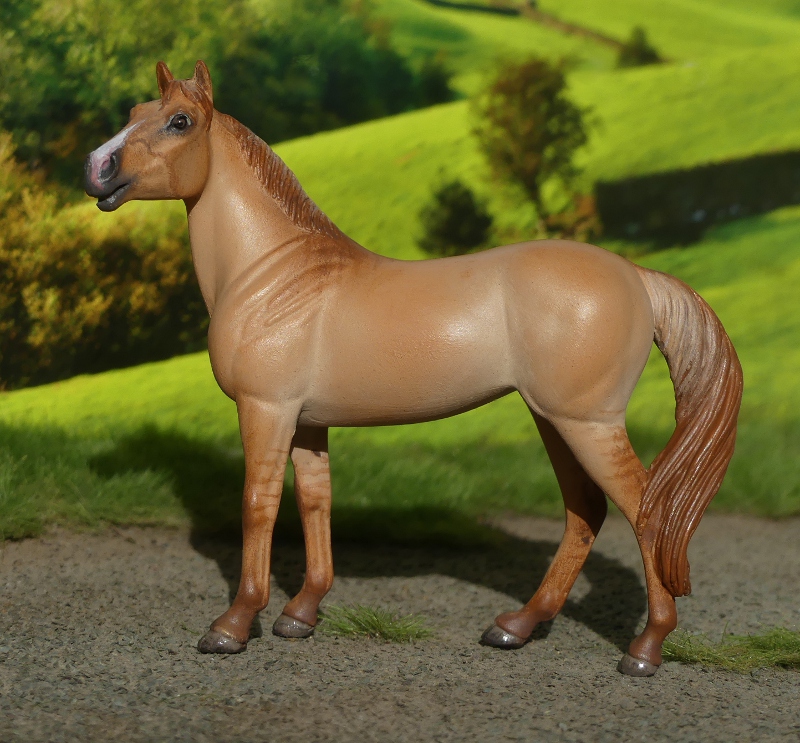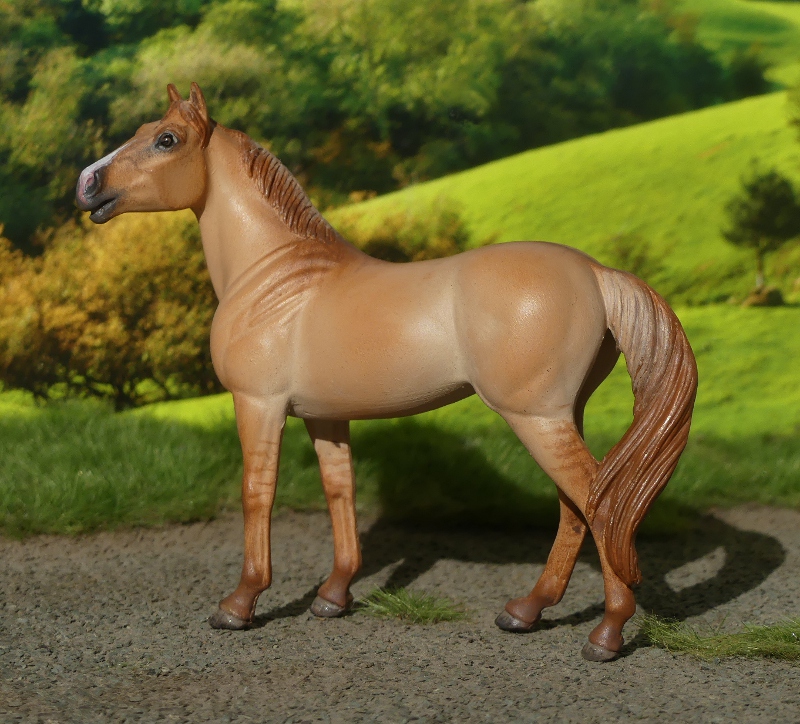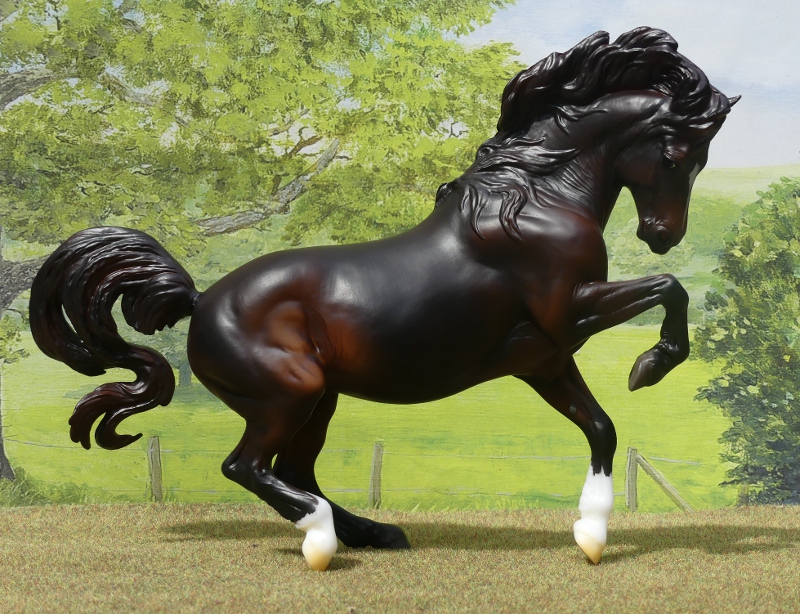Last weekend I was just googling horse colours for the usual mixture of inspiration and entertainment, and it struck me that one of the commonest colours for the saddlebred breed is a solid liver chestnut, and I'd never painted one on the little G2 mould I have so many of, so it was off to the body box to get out one of my unpainted blanks and give her a coat of paint.
I went for a flaxen chestnut cos the contrast of very pale mane would look so good against the dark coat colour, and I'm glad I did cos I really do like the way she turned out. I love the customising part of the model horse hobby for this reason, it's just so satisfying being able to have an idea then go off and create exactly the horse you want to own!
Despite not being as flashy as all her pinto sisters in my herd, a good solid colour makes a nice change and stands out in its own way, I think!
Her original moulded plastic braids I set upon with a scalpel to cut and carve them away, and gave her fine thread braids instead, I don't mind painting in the sculpted ones but I think the 3D effect of plaited thread really adds to the realism in photos, extra detail is always a good thing!
The next custom Stablemate was also a result of random colour googling for amusement one evening, the horse in the photo looked more like a riding pony type and didn't have any white on whatsoever, but I'd been waiting for inspiration for my final Django body and a bay roan pinto just clicked as yes, that'll suit him!
And having completed the paintjob, yes, I think it does - he looks just how I hoped he would! When the usual aim of applying paint with a brush is to get the colour as smooth and blended as possible, roans present a bit of a difficulty, especially the more mottled kind with patchier dark parts - it can be kind of hard to get your head round handling the brush in a way which will deliberatly leave a rougher shading, a suggestion of mixed white and brown hairs. This is why I paint so few of them, but I was determined this time it was the right colour for this horse to be.
I remember a long, long time ago having a discussion with other model horse hobbyists about the rarity of tobiano pintos with a totally solid leg and dark hoof : so many of them automatically come with four socks or stockings, we notice (and maybe try to get a handy reference photo!) when we spot one with a dark leg and black foot. There was even a website at the time, where somebody had collected all the pictures of dark-legged skewbalds and piebalds they could find. So I thought I'd paint one!
The only thing is, I'm now out of Djangos, and that makes me sad cos I've enjoyed making three patchy little cobs out of them, and would happily do three more!
The next two horses are the really, have I never painted that before? batch!
I was messing about amusing myself by making one of those horse colour charts you so often see with small drawings or photos of real horses, some pretty basic and intended for riding school and horse-mad-kids' walls, others more in depth and explaining the genetics for particular colour enthusiasts, breeders, artists, and painters.
I was fitting in pictures of my models for the various basic, variant, and dilute colours, and realised I was actually missing some pretty standard colours in my herd of customs. For a start, I'd never painted a cremello! I thought I had, but when I went to fetch the photo of the one I had in mind to represent the colour on my little chart, he was actually a perlino - oops!
So, another trip to the body box, and I chose a mould that would both be a breed likely to have cremellos, and equally importantly, look good as one!
Another saddlebred! I'd done a dark golden palomino one on this mould, and I've got a much paler palomino my friend painted, but cremello looks easily different enough to warrant picking the mould again, with the cream colour against pink skin, and blue eyes.
Rather than a stripe or blaze which'd reach her nose, I stuck with a forehead star, so there'd be no need to figure out how to handle a face marking on skin which is already pink!
This one has blue braids, to match her eyes. I know the real ribbon colours are chosen to co-ordinate with the browband and rider's outfit (just like some showing classes here use those ribbon browbands which come with a buttonhole or hair bow so the person matches the pony), but for my mini ones I always go for something different picked out to compliment the horse's colouring.
The next big glaring gap on my colour chart was a red dun. How?! Out of all the duns I've ever painted, not one!
So again, time to pick a relevant breed from the body box - this one was part of a batch of cheap Stablemates which I got on ebay, some perfect enough to fill OF gaps in my collection and others which had clearly been very played with, with a lot of scuffs and breaks, missing ears, and legs sellotaped to backs if they hadn't been lost entirely. A while ago I reattached the leg of this unlucky mare (or perhaps lucky, that she didn't just go in the child's bin!), and she's been waiting for a new colour ever since.
I think the colour suits her, it was a toss-up between a stock horse type and a highland when picking what breed body to go with, but I decided to start with this one and I can always do another for my dun highland conga next time. And look, she got the pink nose I avoided on the cremello!
I can tell which leg's been off, but hopefully the milliput join is strong enough that it won't happen again, and neat enough that it's not immediately obvious she had to be reassembled!
Because there was a danger of red dun looking like a bit of a wishy-washy attempt at a chestnut roan, I made sure to give her full-on dun markings, with a barred dorsal stripe, zebra striping to the legs, and frosting along the mane and at the top of her tail. As with the others, she got photographed before getting named, I haven't managed to think of anything to call any of this batch yet!
I need to have another look at my colour chart in progress to see if there's any more glaring omissions, quite how I painted for over a decade without reaching cremello or red dun is beyond me, so who knows what else got missed!















